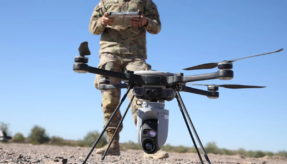
The US Department of Defence has released its Digital Modernization Strategy which will inform their information technology reforms.
The DOD Digital Modernization Strategy serves as the armed force’s Information Resource Management (IRM) strategic plan as well as presenting IT-related goals that will help secure the National Defence Strategy (NDS) and the National Defense Business Operations Plan (NDBOP). The four areas of focus in the strategy are cyber, c3 the cloud, and AI. DoD CIO Priorities outlined in the report are:
• Cybersecurity
• Artificial Intelligence (AI)
• Cloud
• Command, Control and Communications (C3)
Digital Modernisation Goals:
• Innovate for Competitive Advantage
• Optimise for Efficiencies and Improved Capability
• Evolve Cybersecurity for an Agile and Resilient Defense Posture
• Cultivate Talent for a Ready Digital Workforce.
The NDBOP’s goals for the financial years 2018-2022 include readiness, stronger alliances, and reform of business practices. Part of this includes recognising the growing influence of technology in defence. At the start of this year, the DOD certified a change to military budgets that will mean the CIO will now oversee IT spending.
One focus of the report is innovation to improve competition. The DOD formed the Joint Artificial Intelligence Center (JAIC) to improve AI capabilities and partner with industry to deliver goals. A large part of this goal also includes improving software across the DOD. The department also aims to establish a Cloud Environment to encourage business innovation. Cloud will be used as the base of new cybersecurity ideas as well as for analytics, with the DOD partnering with businesses to secure the cloud and deliver on their goals. The cloud will be used to help businesses send their innovations to the DOD and assess their ideas. There is also a focus on the need to improve cyber resilience and agility. The key principles outlined in the report are isolation, containment, redundancy, layers of defence, least privilege, situational awareness, and physical/logical segmentation of networks, services, and applications. The Department of Defence Information Networks (DODIN) will be established as a single information environment subject to common processes. Cyber defences will sense internal and external threats and take remediation, mitigation, and restorative measures. Command and support services on DODIN will be support by shared awareness throughout the network and security findings will be shared throughout the DOD to the largest possible extent.
The DOD plans to protect classified and sensitive information through the Defence Industrial Base (DIB) Cybersecurity Program. The public-private collaboration allows cybersecurity threat information to be shared with DIB members. The DOD cybercrime centre (DC3) also analyses threats, creates an operational threat picture, and shares mitigations with industry, the armed forces, and interagency partners. The report outlines aims to reform risk management and practices to make them more effective and suitable for the needs of personnel. This includes prioritising critical systems and assets, identifying risks, and adapting cybersecurity to mission requirements. The report also outlines the need for international cooperation to mirror the connected nature of cyber networks. This includes analysing global supply chain threats and expanding hardware and software assurance. Another focus is the need for a workforce with skills in cybersecurity and digital systems. A new Functional Community Maturity Model for DOD civilians will expand training and recruitment in the cyber workforce. This will include the Cyber Excepted Personnel Service systems, incentives, local supplements, and the creation of baseline qualifications for over 50 cyber roles.
The DOD hopes to support the modernisation of IT systems through the Joint Information Environment (JIE). The JIE creates network-wide improvements that can be used on a multitude of platforms, creates DOD-wide IT services, ensures modernisation through coordinated refresh initiatives, improves access to data, and meets mission partner sharing requirements. The JIE features 10 objectives to improve cybersecurity, including modernising network infrastructure, improving regional security, and optimising data centre infrastructure. Technological advancements such as IoT, blockchain, and quantum computing form a large part of modernisation plans. Researchers are experimenting with blockchain to create a protocol that will allow personnel to send secure messages that can be tracked through a decentralised ledger. Through IoT, they aim to use embedded sensors to inform decision making-processes and assess when equipment needs to be replaced or repaired. The DOD will aim to advance its quantum computing abilities to compete with international armies and match the capabilities of adversaries. Other technologies being adopted by the DOD include 5G, AI, big data, evergreen IT, DevSecOps, hyper-converged infrastructure, event-driven computing, software-defined networking, cryptographic modernisation, IPv6, PON, microelectronics, and zero-trust security.
If you would like to join our community and read more articles like this then please click here.
Blockchain cyber resilience cyber security IoT Modernising defence Research Training US DoD








